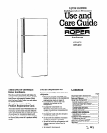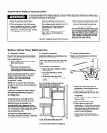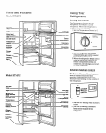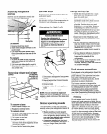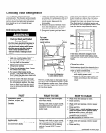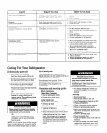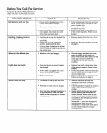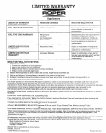
Adjusting refrigerator
shelves
Shelves can be adjusted to match the
way you use your refrigerator
To remove:
1. Remove food from shelf.
2. Slide shelf straight forward to the
guide stops.
3. Lift front until shelf clears stops,
then slide shelf out the rest of the
way.
To replace:
1. Fit back of shelf on top of guides
with wire stops on
the bottom
of
the guides.
2. Lift front and slide shelf in until it
clears guide stops. Slide shelf in the
rest of the way.
Removing crisper and crisper
cover
Lift the back,
then slide out
) the rear
d lift out.
To remove crisper:
1. Slide crisper straight out.
2. Replace in reverse order.
To
remove cover:
1. Lift back, then slide to the rear until
the front can be lifted.
2. Lift cover up and out.
To replace cover:
1. Slide the front cover tabs in from
the rear of the front supports on the
refrigerator walls.
2. Lower back of cover into place.
Ice cube trays
Energy saving tips
Remove ice by slightly twisting the tray
with both hands.
NOTE:
The longer ice cubes are stored.
the smaller they get. Slow evaporation is
caused by the movement of cold air.
Changing the light bulb
I
Electrical Shock Hazard
I
Unplug the refrigerator or
disconnect the main electric power
supply to the refrigerator before
changing a bulb. Failure to do so
can result in electrical shock or
iniunr.
1. Disconnect refrigerator from power
SUPPlY’
2. Reach behind the Control Console
to find bulb
3. Remove bulb.
4. Replace with a 40-watt appliance
bulb.
5.
ReCOMeCt
power
Supply.
NOTE:
Not
all commercial appliance
bulbs will fit your refrigerator. Be sure to
replace a bulb with one of the same size
and shape.
Normal operating sounds
You can expect to hear the following
sounds when your refrigerator-freezer is
operating:
. Water sounds
as water gurgles
through tubing for a few minutes
after refrigerator stops
running. YOU
may
also hear defrost water running
into the defrost water pan.
. Operating sounds
from the high-
efficiency compressor and motor. It
may run longer than your older
refrigerator.
Check the door gaskets for a tight
seal. Level the refrrgerator to be
sure of a good seal.
Clean dust and lint
from the
condenser coils every other month.
Open the doors as seldom as
possible. Decide what you need
before you o;jerr the door. Remove
everything you need at one time.
Organize and label food so you will
not have to search for items you
want. Close door immediately after
you remove food items.
Store food in the refrigerator and
freezer so that air movement is not
blocked.
Set the refrigerator temperature so
that the drinks remain cold enough
for your family’s taste and ice cream
remains firm. Do
Not se!
temperature colder than it needs to
be.
Set the Exterior Moisture Control to
the OFF position unless moisture
forms on the outside of the
refrigerator.
m Do Not install your refrigerator next
to your range, water heater,
furnace, radiator, other heat sources
or in direct sunlight.
Food storage suggestions
Food placed in the refrigerator should be
wrapped or stored in air and moisture
proof material. This prevents food odor
and taste transfer throughout the
refrigerator. For dated products, check
code date to ensure freshness.
The freezer section is designed for
storage of commercially frozen food and
for freezing food at home. For further
information about preparing food for
freezing or food storage times, contact
your local Cooperative Extension Service
or check a freezer guide or cookbook.
Freezing
Do not expect your freezer to quick-
freeze any large quantity of food. Put no
more unfrozen food into the freezer than
will freeze within 24 hours. (No more
than 2 or 3 pounds of food per cubic foot
of freezer space.) Leave enough space
for air to circulate around packages. Be
careful to leave enough room at the front
so the door can close tightly. Storage
times will vary according to the quality
of the food, type of packaging or wrap
used (air and moisture proof), and
storage temperatures which should be
0°F (-17S”C).



